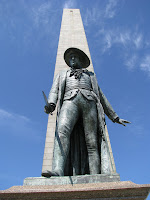Friday April 23th and the PhD trip is almost over. To celebrate the end of this trip we had a very nice party yesterday in the basement of the hostel, with lots of beer, chips and pool-balls. Because a number of people stayed up very late it took a while for everyone to get out of their beds and assemble downstairs for our departure. After Anja and Elsbeth collected all the keycards and checked us out, we said goodbye to Nirmal, Francisco, Martha and Thomas who would stay in the US for a week more.
The ride to the airport was short and handing over our rental cars was not difficult either. So with still a lot of time to go we took the shuttletrain to the terminal. Until so far everything went very smoothly, but then ...
At arrival at the check-in counters we tried to check in with no success, except for Lena, but she had a place on a later flight. The rest of us made a queue to the counter and we waited for our turn. Norhan and Rianna also had to go on that same flight as Lena. The other 14 of our group however could not be found in the system. Tension was increasing, but thanks to a very, very helpful lady behind the counter and a lot of telephone calls and waiting she found out what happened. Our original KLM flight was canceled and replaced by a Delta flight. This meant new eticket numbers, but these new numbers had not been relayed to us. Remko contacted our travelagency in Holland and after a lot of waiting and more calling we could make everybody have happy faces again. OK we were not sitting as a group like on the flight in, but we at least had seats. Unfortunately Norhan, Lena and Rianne had to take a flight at 2200 instead of our 1830 flight. Thankfully though,we had a very friendly, persistent and patient lady at the Delta Airlines desk who helped us. We didn't have any stroopwafels left, so instead we gave her a one of our booklets.
We spent the final hours before boarding with a little shopping, some food and again a lot of waiting.
Around 1800 we finally started boarding and it was kind of sad and ironic to see that there were still a number of seats empty, seats that could easily have been filled by Rianna, Norhan and Lena.
Everyone was boarded and right on schedule we left the gate for the runway, and there we stayed. First the captain told us there was a minor 'incident' with one of the passengers. Then, a couple of minutes later, he asked if there was a doctor in the plane. A very cliche thing to say in a plane, but for us the passengers a little worrying. Two people went to the front and a after a while the captain announced that there was a small child with chickenpox on the plane and that we were returning to the gate. The captain didn't want to take the risk of infecting other passengers on this 7 hours flight. Our return to the gate caused a lot of panic under the passengers, because a large portion of the plane were people who had been stranded in the US and had to take connecting flights in Amsterdam. The captain calmed everyone by saying that this flight would continue and that only the sick child with his family had to go off the plane and that after refueling and removing their luggage we would continue. In the end that was a little over two hours later that we took off form the runway of JFK. The cabin-crew tried their best to keep morale high by making jokes and distributing our diner right away. Especially the joke about us making a detour to Iceland and sacrificing a number of passengers and crew to the volcano to appease the volcano-gods got a lot of laughter from the plane.
The rest of the flight went by quite fast. Some of us were able to sleep a little, but for the others it was quite hard to sleep in the small chairs. Around 9:30 we could see the coastline, a sight which was greeted with a lot of joy and happiness. We landed around 10 o'clock and at 10:30 we left the arrivals-hall of Schiphol. Our group got smaller and smaller, first we had to leave people at the hostel, then a couple more at JFK and at Schiphol everyone went their own way and it was just me, Anja and my wife in the train to Ede-Wageningen. We lost the rest of the people going by train somewhere at Schiphol and we managed to take a different train.PhD-Trip 2010 was done. It was a great experience, we had a lot of fun, a lot of interesting experiences,a lot of new information and a lot of stress, but in the end only we will only remember the happy things.
Up to the PhD-Trip 2012!








